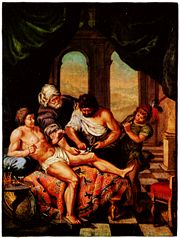Wound
| Wound Classification and external resources |
|
| ICD-10 | T14.0-T14.1 |
|---|---|
| ICD-9 | 872-893 |
| MeSH | D014947 |

In medicine, a wound is a type of injury in which the skin is torn, cut or punctured (an open wound), or where blunt force trauma causes a contusion (a closed wound). In pathology, it specifically refers to a sharp injury which damages the dermis of the skin.
Contents |
Types of wounds


Open
Open wounds can be classified according to the object that caused the wound. The types of open wound are:
- Incisions or incised wounds, caused by a clean, sharp-edged object such as a knife, a razor or a glass splinter.
- Lacerations, irregular tear-like wounds caused by some blunt trauma. For example, a blunt impact to soft tissue that lies over bone, or a tearing of skin and other tissues caused by childbirth. Lacerations from blunt impacts may show bridging, as connective tissue or blood vessels are flattened against the underlying hard surface. The term laceration is commonly misused in reference to incisions.
- Abrasions (grazes), superficial wounds in which the topmost layer of the skin (the epidermis) is scraped off. Abrasions are often caused by a sliding fall onto a rough surface.
- Puncture wounds, caused by an object puncturing the skin, such as a nail or needle.
- Penetration wounds, caused by an object such as a knife entering the body.
- Gunshot wounds, caused by a bullet or similar projectile driving into or through the body. There may be two wounds, one at the site of entry and one at the site of exit, such is generally known as a through-and-through.
In a medical context, stab wounds and gunshot wounds are considered major wounds.
Closed
Closed wounds have fewer categories, but are just as dangerous as open wounds. The types of closed wounds are:
- Contusions, more commonly known as bruises, caused by blunt force trauma that damages tissue under the skin.
- Hematomas, also called blood tumors, caused by damage to a blood vessel that in turn causes blood to collect under the skin.
- Crushing injuries, caused by a great or extreme amount of force applied over a long period of time.
Healing
To heal a wound, the body undertakes a series of actions collectively known as the wound healing process.
Infection
Bacterial infection of wound can impede the healing process and lead to life threatening complications. Scientists at Sheffield University have identified a way of using light to rapidly detect the presence of bacteria. They are developing a portable kit in which specially designed molecules emit a light signal when bound to bacteria. Current laboratory-based detection of bacteria can take hours or even days.[1]
Cultural history

From the Classical Period to the Medieval Period, the body and the soul were believed to be intimately connected, based on several theories put forth by the philosopher Plato. Wounds on the body were believed to correlate with wounds to the soul and vice versa; wounds were seen as an outward sign of an inward illness. Thus, a man who was wounded physically in a serious way was said to be hindered not only physically but spiritually as well. If the soul was wounded, that wound may also eventually become physically manifest, revealing the true state of the soul.[2] Wounds were also seen as writing on the "tablet" of the body. Wounds gotten in war, for example, told the story of a soldier in a form which all could see and understand, and the wounds of a martyr told the story of their faith.[2]
References
- ↑ "Light to detect wound infection" (web). UK scientists have identified a way of using light to rapidly detect the presence of bacteria. bodat. BBC News (11 March 2007). Retrieved on 2008-03-17.
- ↑ 2.0 2.1 Reichardt, Paul F. (1984). "Gawain and the image of the wound". PMLA 99 (2): 154-161. doi:.
See also
- International Red Cross Wound Classification System
External links
- Wounds, online open-access journal featuring articles about wound care and related research.
- Ostomy Wound Management, online open-access journal featuring articles about wound care, ostomy care, incontinence care and nutrition
- Journal of Burns and Wounds, online open-access journal featuring articles about wound care and related research
- US based wound healing society
|
|||||||||||||||||